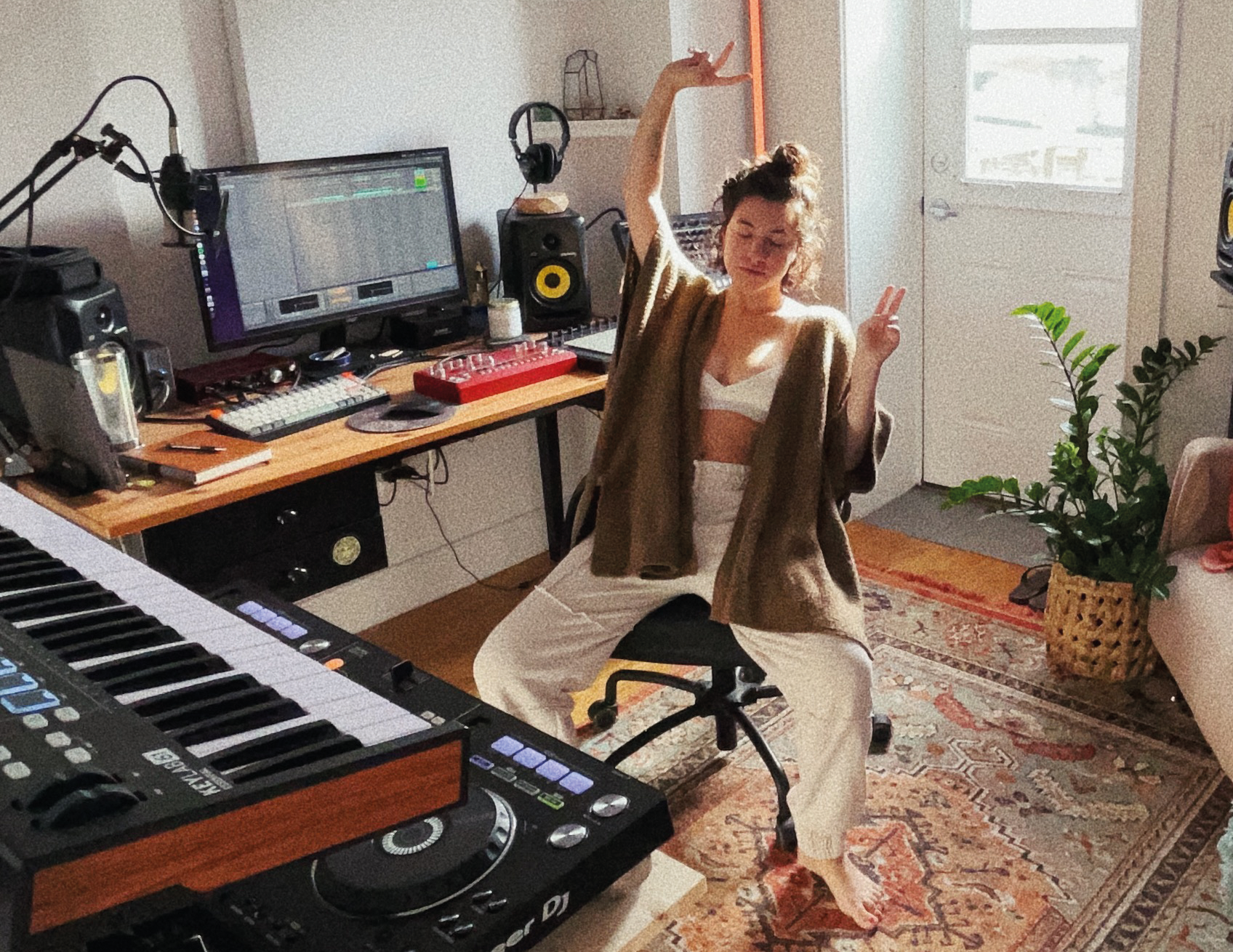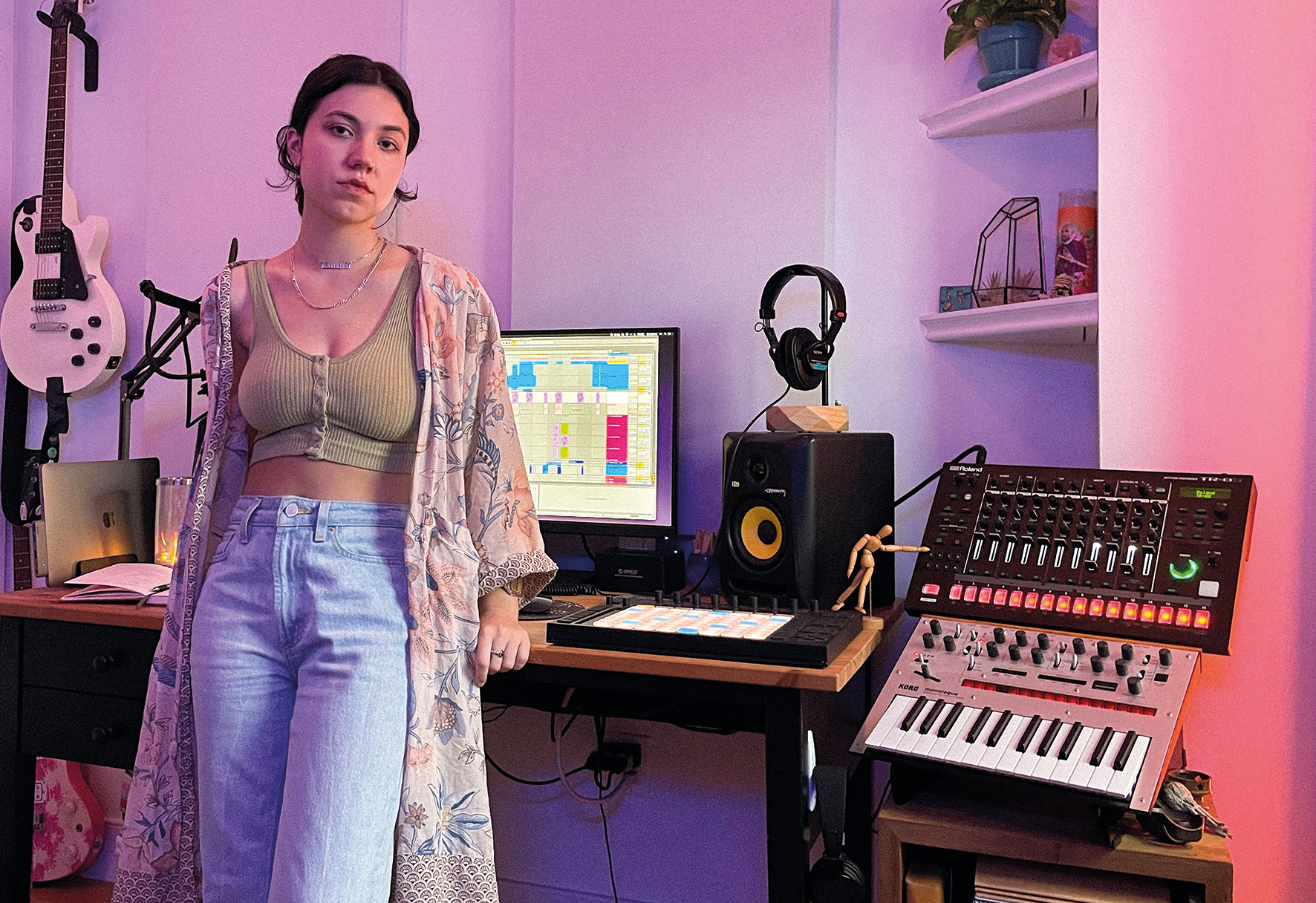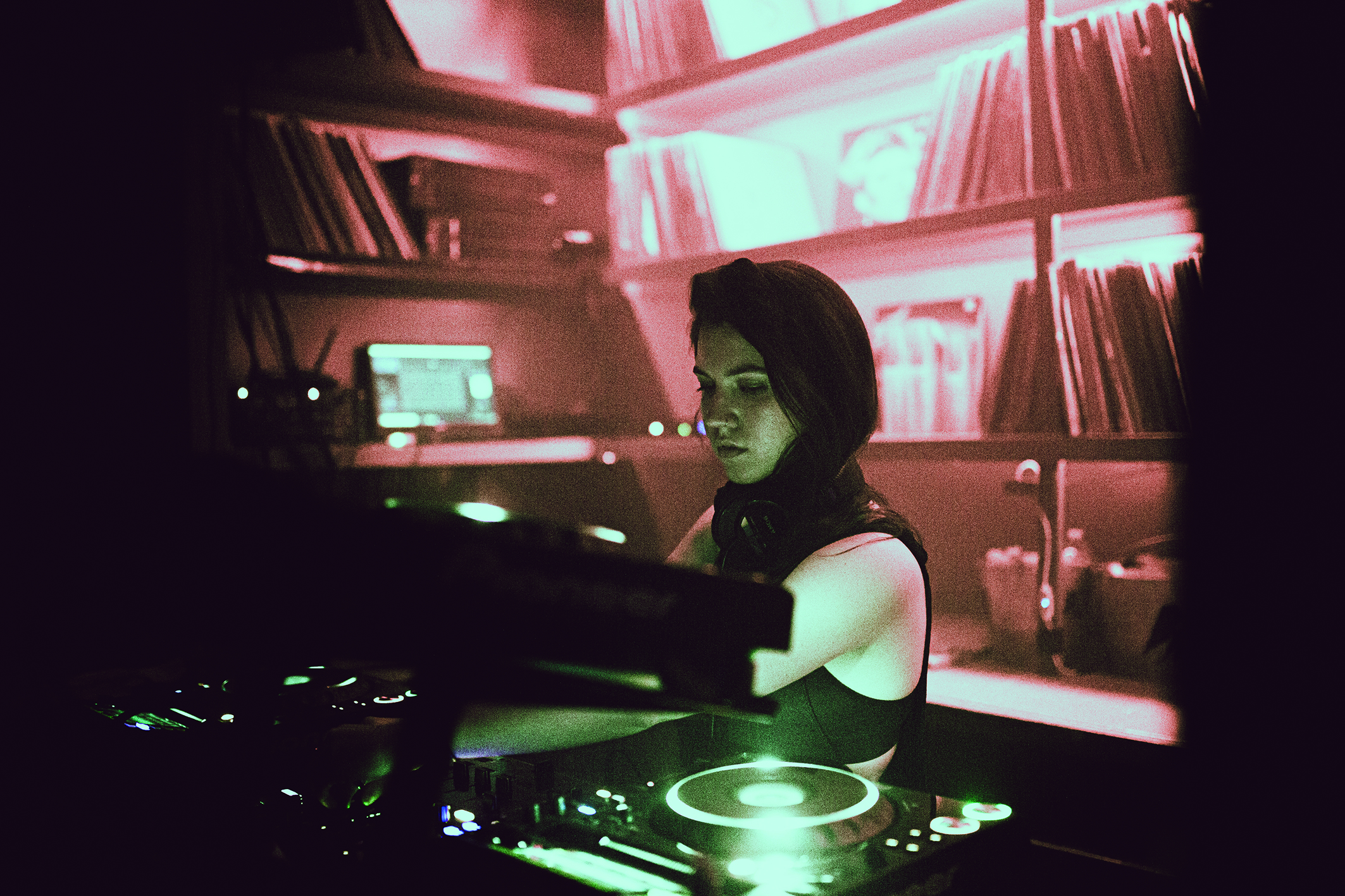QRTR: "It made sense to have ready-made effect chains and custom sounds, so that you can throw these little pieces on to a track, and suddenly it’s yours"
Brooklyn-based artist QRTR has garnered rising acclaim for the ethereal pulse of debut LP Drenched, and for her euphoric DJ sets

Awash with lavish synth textures, mangled ghostly vocals and head-bobbing house beats, QRTR’s debut album Drenched is certainly among the most characterful debuts we’ve spun recently.
Built using a sound design ethos that resulted from years of professional study, merged with a love of transcendent house music, Meagan Rodriguez’s electronic alter-ego has carved a beguiling sonic identity.
The three main facets of her life as QRTR – that of sound designer, gigging DJ and an experimental electronic artist – are all integral to her approach to making tracks that skirt around the dance music genre, while still diving headfirst into its tropes if she feels the need - examples of which include the trance-like movement of the hypnotic You Won’t Return, or the lo-fi synth stammers of My Bad.
Making up for lost time after 2020’s Covid-19 restrictions with a full schedule of live shows, we spoke to Meagan the morning after a particularly exuberant set, to share her story, talk tech and explain more about her process.

Hi Meagan, firstly can you give us a bit of background on yourself and how you first started music-making?
“I’ve loved music my whole life; I did music classes growing up in elementary school, and though I never specialised, I always loved it. My parents really encouraged it, too; they’d buy me different instruments every Christmas. They knew it brought me joy.
"Really, I didn’t start producing music until I was in middle school. My dad bought me a Sony VAIO tower PC. It came with a bunch of Sony creative software. I used the early version of Acid as my main music software, and I’d sample things using a little PlayStation 2 microphone!
Want all the hottest music and gear news, reviews, deals, features and more, direct to your inbox? Sign up here.
“I’d sample noises that I made myself, or even songs that I heard on the radio. I would then mess with the frequencies and the EQ to remove the vocals from the track so that I could add my own in. I was only 11 at this point, so I didn’t really know what I was doing, but it was fun. I’d burn CDs of me singing on top of tracks and force them on my friends on the school bus.
The trick is getting that one piece that suddenly puts you into a flow. Every artist is trying to do that when they’re in the studio
“I got my first MacBook in high school which had GarageBand, and I started making a few tracks in that. I never considered making music in any kind of career capacity. I actually ended up going to film school and focused on post-production.
"There I studied sound design and have been working in that capacity for ten years, and I still do some work in that domain. I’m still occasionally called on for music editing and music supervision jobs. It wasn’t until around 2014 that I started going to my first music festivals and dived into the nightlife of New York City. DJing was just a hobby at first.
“Around this time, I first bought Ableton Live and then started dabbling and having fun with it. Totally organically, I had friends who were just like, ‘hey, do you want to open our show as a DJ?’. Then I just started playing from there, and started taking it a bit more seriously, over the last six years.”
So you never had sights on establishing yourself as an artist?
“I never had any big visions about being a music artist, playing sold out shows or anything like that. It was entirely built around having parties and making a vibe and a good time. It evolved from there.”
How important is the cinematic mindset when writing? Is that still important?
“I think it’s huge. It was around 2017 when I started to take music more seriously. I decided to try and create a sonic ethos. This basically involved digging into my background in sound design and post-production, to create much more cinematic dance music – combining the two things that I was really interested in, even though they’re quite contradictory.
"I wanted to make things more melodic and feel-based. I’d already acquired quite a few sound effect libraries over the years, from doing different jobs. So I used these a lot to add more dynamic feelings.”
Last year’s Drenched had a lot of textural variety to it. It had a really distinct, ethereal atmosphere, with lots of big reverbs and delays. Did you start with a guiding concept for the album?
“It was really the second track on the record, called All Of My that I’d recorded before everything else that unlocked the sound. I was approached by the label Dome of Doom to make the album, so I was trying to decide which direction to go down on the record, and was scrolling through some older tracks.
It made sense to have ready-made effect chains and custom sounds, so that you can throw these little pieces on to a track, and suddenly it’s yours
"I remember recording All Of My at the time feeling like it was maybe too much in the sound design world. But when I heard it again, the thought of really fleshing out that concept appealed to me.
So that track informed the whole language of the record. I really wanted to dig into that etherealness, but still have those accessible dance-tropes within.”

How long did the whole production process take?
“It took about a year, almost exactly. Dome of Doom reached out to me in March 2019 and it was released in March 2020. I finished it technically in November 2019, so a little less than a year – but there were some track ideas pulled from years prior, that I’d tried to reimagine, and then obviously there are new tracks I created specifically for the record.
“The big project, aside from obviously creating all the songs, was to design the sound so that each track sounded cohesive and consistent. That was where the whole conceptual thing came in, I started thinking about how the tracks could connect to each other.”
How does a writing session typically begin for you? Do you have ideas in your head fully-formed or do you go down more of a journey of discovery?
“I would say both really. It does vary track-by-track. There’s been plenty of times when I’ve been driving and listening to the radio, then suddenly I have an idea in my head, out in the world, so I’ll record a voice memo on my phone (I have hundreds!) of melodic ideas.
“Sometimes if I have a day when I just want to commit to a session I’ll begin with a clear melody, or just with a bed of percussion. It’s all down to how I’m feeling. The trick is getting that one piece that suddenly puts you into a flow.
"Every artist is trying to do that when they’re in the studio. Sometimes it can be immediate, other times it takes most of the day just to get there, then the last two hours are the most productive.”
We imagine that with the sort of flowing, organic vibe of Drenched, a lot of new ideas grew out of other ideas…
“Oh, 100% – at some point early in my life as QRTR, someone told me that it made sense to have ready-made effect chains and custom sounds that were re-used quite a bit, so that you can throw these little pieces on to a track, and suddenly it’s yours… if you’re not feeling that the track is cohesive, you can jump into your bank and play around. I think Drenched was the beginning of that for me.
I use Arturia Analog Lab 4 quite a bit. It’s so huge. I love it
“Now I have so many folders in Live that are named ‘QRTR’, full of big massive chains that I can easily apply to projects. Making the album allowed me to grow so much in that regard, because now I can approach writing and thinking about how it relates to the project as a whole.
"Drenched very much put me in that mindset. I’m proud of how I did it, because I still gave myself room to grow. Even though it is QRTR, it’s eclectic in genre. I’ve got a lot of flexibility now, with that being my debut.”
Where did you make the album and what tech was essential to your process?
“I was working out of my home studio in Brooklyn, actually across two apartments. The first apartment had my studio just in my bedroom, then I moved into a new place where I was able to actually have my own separate studio room.
“Drenched was written using a Hackintosh that I actually built for video editing purposes, and so it was all on there. I recently transferred everything over to a MacBook Pro so I could flexibly work in other spaces without missing my plugins!
“So it was on this Hackintosh primarily. Every track was recorded with Ableton Live and the Push was my primary performance instrument. I also have a Roland TR-8S that I used for quite a few drums and percussive sounds.
"I have an Arturia KeyLab 61 MIDI keyboard for melody writing, and I use Arturia Analog Lab 4 quite a bit. It’s so huge. I love it, I’ve been using it since it came out. On every track that I’ve been working on there’s at least one synth from it.”
The opening of And Still has a nice gnarly lo-fi synth part, how was that achieved?
“Ah well that was actually a real synth! That was done with my Korg Monologue, but the rest were all virtual really. I use Serum sometimes, but Analog Lab primarily. Some Ableton stock synths were brought in a bit, too.
I’ve been pretty wary of the hardware synth world, because I don’t want to go bankrupt!
“I feel like I’m more aware of the plugin world now I’ve finished making the album. I just bought Massive X, which I’m really excited to try out; I literally just downloaded it. I have a lot of effect processing plugins now that I didn’t have before. I think honestly I use a lot of Ableton stock packs just chained together.
“I was using Ableton 9 actually when I started Drenched. I was scared to upgrade during the process. I figured I’d make the switch once it was finished. When I did I was a bit annoyed, there was so much great stuff in the Live now, like echo and reverb effects that are so much stronger. The newer reverbs have a lot of real complexity that I’ve started exploring more for a new project.
"I ran the gamut with the new Ableton stock. There’s all the additional Max for Live packs which are so awesome. There’s one that I’ve been using a lot called Dr Chaos. It’s like these probability pack things; it is so cool and it’s so great if you’re ever stuck in a session. You can just play around in a track and introduce some chaos. It can steer you into new directions.”
Vocal manipulation plays a part in quite a few of your tracks, like the backwards vocals on your single Forest Sprint, or the skittering vocals on I Gave Up. What do you use to mess with vocals, and do you see them playing more of an instrumental role in the mix?
“It’s rare that I finish a track and feel like it’s fine without some sort of vocal. There’s something about electronic music where having a human voice in there helps to pull people in. So, I tried to sprinkle them where I could. On my next project I’m doing quite a bit of my own vocals, and I did on Drenched as well.
“In terms of processing, I really like to chop things up and take the organic-ness of the human voice and bring it into the electronic space by manipulating it. The way I’d describe my fixation with chopping vocals is that I’d love for people to hear a track of mine in a club, and not be able to figure out what’s being said.
"They then create little meanings in their heads, depending on their own state of mind. I find that really fascinating. Like what’s in the audience’s mind that they want to project onto these distant vocals?
If you do have ambition to make it professionally, don’t lose sight of those fun parts
“That being said, I am challenging myself a little more to bring in a more mainstream vocal treatment into the sounds that I create. I’ve been doing that with some remixes recently.
"I’ve done a collab with house DJ Benwah called Lost In You which has more of my actual vocals which I’ve processed together with his vocals, and you can understand what’s being said there. But it’s still treated. There’s something about taking that organic sound and trying to reimagine it.”
The lines between a DJ and electronic producer are more blurred than ever now. Would you define yourself as one or the other, or both?
“I would primarily refer to myself as a music producer. I see that in terms of what my goals are for myself down the road. That’s where I want to put in the most effort, to excel as a music producer. I also absolutely think I’m a good DJ, too!
"I think there’s a certain expectation that you have to do both in the electronic space, but I think some people are really good DJs and just aren’t interested in producing or vice versa.”

Drenched came out right on the eve of Covid sweeping the world. How did you spend lockdown, and do you think it has affected your music? It must have been tough not being able to get out there and play live?
“It came out literally right at the beginning of major lockdowns across the world. The concept of Drenched was very much trying to create euphoric moments within an overwhelming moodiness. It was actually really relevant to what we would all experience.
"In that way, I don’t think that’s changed in terms of what I’m trying to do with my music now. But to have the year to unfold as it did, was a very weird experience for me. It felt very on-the-nose! The last year and a half I’ve been working on quite a lot of music… that feeling of solitude and isolation has definitely seeped into the music I’ve been making recently.”
What advice would you give to any of our readers who are keen to become an artist like yourself?
“There’s a great quote from Caribou on that, that I completely agree with. He says, ‘I don’t claim any special insight into music, just enthusiasm – if I did it, you can too’. That’s totally it… just do it to enjoy yourself, have fun and if you do have ambition to make it professionally, don’t lose sight of those fun parts.
“I had a lot of imposter syndrome in the very beginning. You just have to shake it off because, y’know, it’s dance music. If you’re trying to make dance music then it’s inherently supposed to be fun. So don’t think too much about it. If you don’t know where to begin, then YouTube (and tutorials) are a great place to begin.”
Is there any tech that you’d love to get your hands on, or any kinds of sounds/genres that you’d be keen to explore in future tracks?
"Well I’ve been pretty wary of the hardware synth world, because I don’t want to go bankrupt! But I think it would be very cool to buy a few more. I’ve been going to a few other studios of people who have more hardware synths and enjoying playing around and getting more into the synthesis world. The modular world is pretty interesting to me too.
“I’ve always been conscious of pigeon-holing myself in terms of the music I’m creating. I’ve got some new music coming out later this year which I’m really excited about. I think I want to experiment a bit more, and not be afraid to do that.”
What’s next on your agenda?
“This year I’m playing my first real festivals as a DJ and producer. One is on the West Coast called 808s and Heartbreaks, and another in Upstate New York called Luminescence. Then I have something really big happening in September, which I think will be a step toward something. But I can’t reveal what it is yet!”


Computer Music magazine is the world’s best selling publication dedicated solely to making great music with your Mac or PC computer. Each issue it brings its lucky readers the best in cutting-edge tutorials, need-to-know, expert software reviews and even all the tools you actually need to make great music today, courtesy of our legendary CM Plugin Suite.
